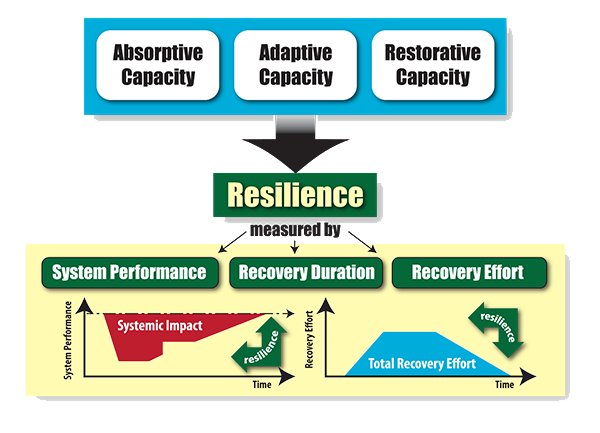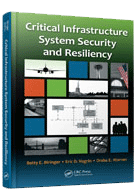
Strategic design to sustain critical services efficiently following a disruptive event
Critical infrastructure systems provide essential services that are vital to the nation’s security, public health and safety, economic vitality, and way of life. Without energy, transportation, telecommunications, and other critical infrastructure services, the country would suffer debilitating effects. Critical infrastructure resilience is determined by an infrastructure system’s ability to deliver essential services in the event of disruptive incidents, by how it absorbs, adapts to and recovers from those disruptive events.
Ensuring resilience to disasters requires the ability to analyze infrastructure resilience in a technically defensible and objective manner. Doing so requires assessing elements such as pre-disruption investments, post-disruption recovery, resilience costs, resource allocation, and various network elements. Research efforts have demonstrated this type of resilience analysis can be achieved by integration of infrastructure modeling, mathematical theory, and network analysis, techniques that can be used to design resilience into new as well as existing infrastructure systems.

The private sector and federal, state, and local governments are applying critical infrastructure resilience strategies to their asset security activities. In support of DHS’s resilience mission, Sandia National Laboratories formulated a unique assessment framework for evaluating the resilience of critical infrastructure and economic systems. This framework is the first of its kind that is flexible enough to consider all types of critical infrastructure systems and a range of analysis methods while explicitly evaluating resources, recovery costs, and feedback loops between recovery activities and system performance.

Sandia National Laboratories authors Betty E. Biringer, Eric D. Vugrin, and Drake E. Warren detail a practical framework for developing an effective protection system that can mitigate and even prevent undesired events altogether.
The authors’ methodology provides an integrated approach to security risk assessment that can be produced for a variety of critical infrastructure assessments.
Journal Papers
Modeling Hospitals’ Adaptive Capacity during a Loss of Infrastructure Services, Journal of Healthcare Engineering, 6(1): 105-140. March 2015
Modeling Evacuation of a Hospital without Electric Power, Prehospital and Disaster Medicine. 2015 (online publication)
Evaluating the Effect of Resource Constraints on Resilience of Bulk Power System with an Electric Power Restoration Model, International Journal of System of Systems Engineering, 5(1), pp. 68-91. 2014 (online publication)
Optimal Recovery Sequencing for Enhanced Resilience and Service Restoration in Transportation Networks, International Journal of Critical Infrastructure, 10(3/4), p.218-246. 2014 (online publication)
Resilience Certification for Commercial Buildings: a study of stakeholder perspectives, Environment Systems and Decisions, 33(2), pp 184-194. 2013 (online publication)
Advancing Cyber Resilience Analysis with Performance-Based Metrics from Infrastructure Assessments, International Journal of Secure Software Engineering Special Edition on Cybersecurity Scientific Validation, 2013 DOI:10.4018/jsse.2013010105 (online publication)
Design for Resilience in Infrastructure Distribution Networks, Environment Systems and Decisions, 33(1), pp 104-120 2013 (online publication)
Infrastructure resilience assessment through control design, International Journal of Critical Infrastructures, 7(3). 2011 (online publication)
A Resilience Assessment Framework for Infrastructure and Economic Systems: Quantitative and Qualitative Resilience Analysis of Petrochemical Supply Chains to a Hurricane, Process Safety Progress, 30(3), pp. 280-290. March 2011 DOI 10.1002/prs.10437
Reports
Development of an Urban Resilience Analysis Framework with Application to Norfolk, VA, Sandia National Laboratories report, March 2016
Presentation
Measuring & Influencing Resilience of Adapting Flow Networks, presented to Sandia National Laboratories’ External Complex Systems Advisory Panel, August 2014